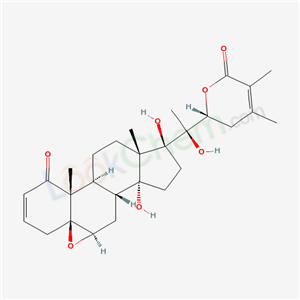Multi-step reaction with 19 steps
1: (TMS)2NH, Et3N / 1,2-dichloro-ethane / 0.75 h / -23 °C
2: 1.) Pd(OAc)2, K2CO3, 2.) p-toluenesulfonic acid / 1.) CH3CN, 12 h, 2.) reflux
3: 1.) tetrabutylammonium periodate / 1.) CH2Cl2, 2.) 0 deg C, 20 min
4: 1.) H2, 2.) aq. CuCl2 / 1.) 5percent Pd-BaSO4 / 1.) EtOH, 3 h, 2.) THF, 4 h
5: 100 percent / 5percent KOH / methanol / 2 h / Heating
7: tetrahydrofuran
8: i-Pr2NEt / dioxane / 24 h / 80 °C
9: osmium tetraoxide, pyridine
10: 89 percent / TFAA, DMSO, Et3N / CH2Cl2 / 1.5 h / -78 °C
11: 97 percent / tetrahydrofuran / 1 h / -78 °C
12: 65 percent / i-Pr2NEt / dioxane / 24 h / 90 °C
13: 1.) O3, 2.) Me2S / 1.) MeOH, -100 deg C, 2.) 30 min
14: 1.) LDA / 1.) THF, HMPA, 2.) from -78 deg C to RT, 1.5 h
15: 2 M aq. H2SO4 / dioxane / 36 h
16: 72 percent / DMAP, pyridine / 15 h
17: 78 percent / oxidation
18: 1,5-diazabicyclo<4.3.0>non-5-ene / CH2Cl2 / 0.67 h
19: MCPBA, NaHCO3 / CH2Cl2 / 18 h
With
pyridine; dmap; palladium diacetate; potassium hydroxide; osmium(VIII) oxide; dimethylsulfide; sulfuric acid; DBN; hydrogen; sodium hydrogencarbonate; potassium carbonate; tetrabutylammonium periodite; toluene-4-sulfonic acid; ozone; dimethyl sulfoxide; triethylamine; N-ethyl-N,N-diisopropylamine; 3-chloro-benzenecarboperoxoic acid; 1,1,1,3,3,3-hexamethyl-disilazane; trifluoroacetic anhydride; copper dichloride; lithium diisopropyl amide;
palladium on barium sulfate;
In
tetrahydrofuran; 1,4-dioxane; methanol; dichloromethane; 1,2-dichloro-ethane;
DOI:10.1021/ja00003a058




